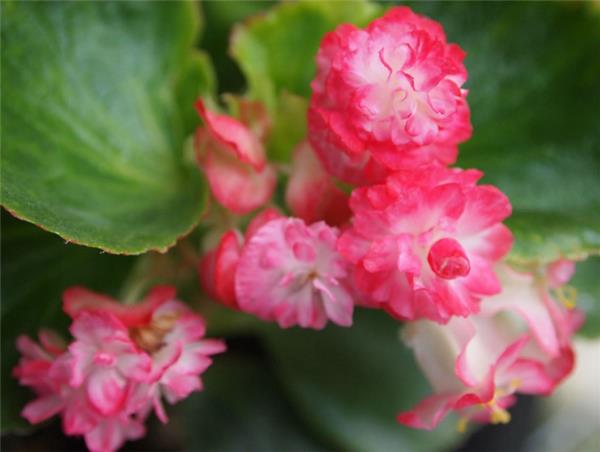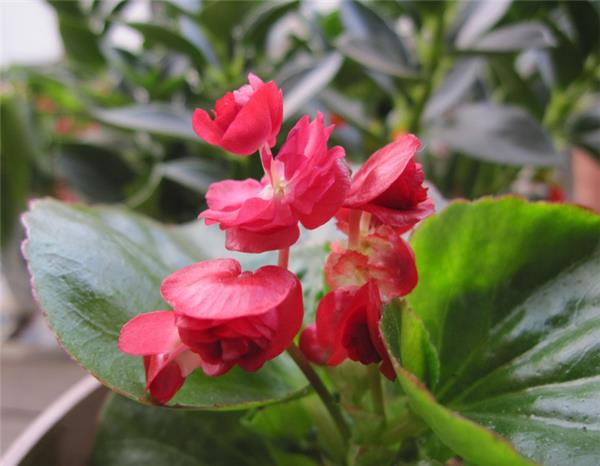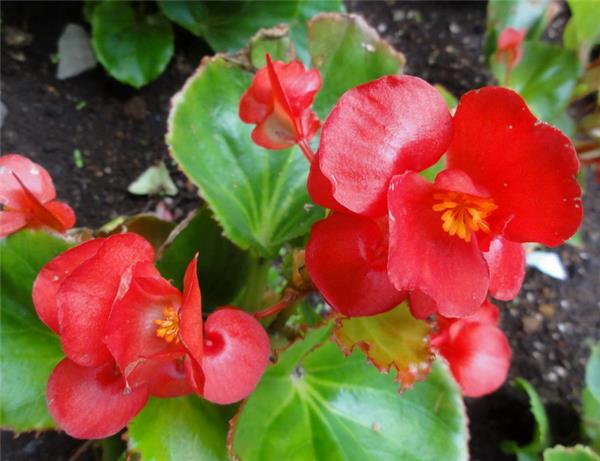Culture method of double four-season Begonia
Double petal four seasons begonia flower is a classification of four seasons begonia, today we want to introduce to you is double petal four seasons begonia breeding method, let's take a look!

Culture method of double-petaled begonia
1. Fertilization
During the growth period, the fertilizer should be applied according to the leaf color and leaf growth of the plant. Too much fertilizer should not be applied, otherwise it will lead to excessive leaf growth and affect flowering. Appropriate amount of phosphorus and potassium fertilizer should be applied before flowering to improve flowering quality.
2. Winter
When winter comes, dig up bulbs and hang them in dry and ventilated places or put potted flowers in warm indoor places for winter.
3. Prevention of diseases
During the period of high temperature and dryness, root rot and stem rot easily occur in Malus persica. At the early stage of discovery, watering should be controlled in time, and carbendazim should be sprayed for control. Continuous use for a period of time visible efficacy.
4. Basin soil
The mixed soil of river sand, moldy leaf soil and snake sawdust was the most ideal. Begonia four seasons fear heat, summer should be placed in a cool place maintenance.
5, watering
Begonia likes warm conditions, so during growth, it should be watered according to plant growth and temperature changes. Water less during germination and keep the pot soil slightly dry. If it is too wet, it will lead to rotten roots. Water the plant every two days during the growing season, and spray water around the plant frequently to increase air humidity. Another thing to note is that when watering, do not pour the leaves and stems from the top, but pour along the edge of the flowerpot, otherwise the stems and leaves are easy to rot.

6. Winter and summer management
Begonia winter and summer due to the impact of temperature, growth is relatively slow, need to strengthen fertilizer, water management.
7. Sunlight
In the midsummer high temperature season, do not avoid the four seasons begonia by the direct light, so that the four seasons begonia sunburn.
8, picking
Four seasons begonia after the flowers must remember to remove the heart in time, remove the residual flowers, so that it can grow more luxuriant.
9. Pests
The common pest of Malus asiatica is leaf roller moth, which directly affects the growth and development of Malus asiatica by eating tender leaves and flowers as larvae. For this case, if it is not particularly serious, it can be caught manually. For serious cases, it should be sprayed with dimethoate diluent.
10. Place
The flowerpot of Four Seasons Begonia should be placed on the balcony or courtyard for semi-shade maintenance at ordinary times. Do not let direct sunlight come in, and pay attention to ventilation. Half a month after planting, a decomposed fertilizer water can be applied. In the later growth period, light fertilizer water can be applied every 20-30 days. In winter, it should be moved indoors and placed in sufficient sunshine, and the minimum temperature should not be lower than 10 degrees.

How to make a double four season apple graft
Branches:
Grafting time is generally good when the terminal buds begin to sprout in early spring. Scion is a full-bodied annual branch cut last autumn, cut into 6 to 10 cm long segments, each with at least two full buds. The scissors are often sealed with paraffin to retain moisture. During grafting, the scion is cut into two symmetrical inclined planes of different sizes with a cutter, one inclined plane is 1.5 to 2.0 cm long and the other is 0.8 to 1.0 cm long. The surface must be smooth, preferably cut into a knife. At the same time, cut the rootstock at about 20 cm from the ground, and cut a crack downward at the north side of the rootstock section, with a depth of 2.0 to 2.4 cm. Then insert the scion with its long cut face inward into the cut in the rootstock. A lateral cambium must be aligned with the cambium on one side of the rootstock, preferably on both sides if the rootstock and scion are of similar thickness. And then tie it with plastic. Such as small plastic bags tied in grafting better, in case of evaporation of water.

Bud grafting:
Grafting time in autumn around August. Select the appropriate seedlings to complete the rootstock, scion is begonia, should choose healthy without diseases and insect pests, full buds, upright upward growth of 1-year-old branches, with the pick with the next. Bud grafting is a kind of grafting method which is not limited by seasons, easy to operate and high survival rate. Sticking bud grafting is similar to embedding bud grafting, but the bud grafting does not have xylem, so the cambium contact surface of rootstock and bud grafting is larger, healing is easier, and the survival rate is higher. Grafting is carried out in three steps:
Cutting stock: select smooth place at grafting part of rootstock, cut it transversely at lower part first, deep into xylem, then cut it longitudinally along xylem from top to bottom at 2.5cm above transverse incision, and remove peeling.
Bud cutting: bud cutting and rootstock cutting method is the same, using two knife bud cutting method. First cut the bud 1 cm below, then cut the bud 1 cm below along the xylem, and remove the bud. The size of the bud is the same as the peeled size of the rootstock.
Binding: stick the cut buds to the cutting parts of the rootstock, and then bind them. It is best to use soft and elastic plastic strips for binding, so that the sealing effect will be better. Grafting in early spring, because scions have no petioles, when bound, the buds can be sealed together in plastic strips. Grafting in the growing season, cutting buds to leave 1cm long petioles, binding buds and petioles exposed outside.
Remove the peel.
Bud cutting: bud cutting and rootstock cutting method is the same, using two knife bud cutting method. First cut the bud 1 cm below, then cut the bud 1 cm below along the xylem, and remove the bud. The size of the bud is the same as the peeled size of the rootstock.
Binding: stick the cut buds to the cutting parts of rootstocks, and then bind them. It is best to use soft and elastic plastic strips for binding, so that the sealing effect will be better. Grafting in early spring, because scions have no petioles, when bound, the buds can be sealed together in plastic strips. Grafting in the growing season, cutting buds to leave 1cm long petioles, binding buds and petioles exposed outside.
Related
- Wuhan Hospital Iron Tree Blooming Result Was Instantly Frightened by the Gardener Master
- Which variety of camellia is the most fragrant and best? Which one do you like best?
- What is the small blue coat, the breeding methods and matters needing attention of the succulent plant
- Dormancy time and maintenance management of succulent plants during dormancy
- Minas succulent how to raise, Minas succulent plant pictures
- What are the varieties of winter succulent plants
- How to raise succulent plants in twelve rolls? let's take a look at some experience of breeding twelve rolls.
- Attention should be paid to water control for succulent plants during dormant period (winter and summer)
- Watering experience of twelve rolls of succulent plants
- Techniques for fertilizing succulent plants. An article will let you know how to fertilize succulent plants.



